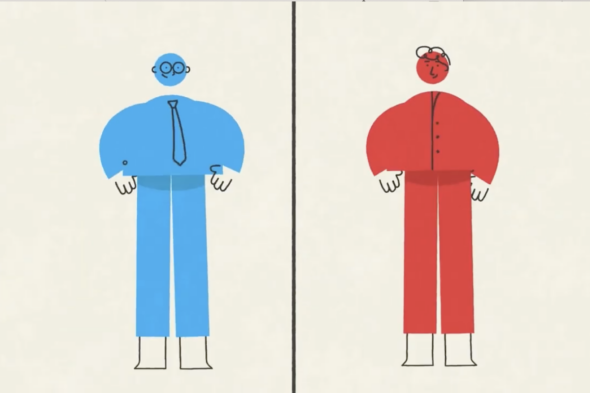UIC video excels in Science megastudy on political polarization
A video made by two UIC psychology professors reduced toxic political polarization, according to a megastudy published in the newest issue of the journal Science.
The results of the study appear in a heated political climate ahead of next month’s presidential election. But the project began two years ago.

Michael Pasek and Rebecca Littman of the UIC Department of Psychology co-created the video, which they entered into Stanford University’s Strengthening Democracy Challenge. It emphasizes how Democrats and Republicans hold inaccurate beliefs about how their political opponents view them.
In 2022, the competition chose the team’s video as a finalist from over 250 submissions, then tested it and 24 other finalist submissions to see which reduced partisan animosity, anti-democratic attitudes and support for political violence. The UIC video was one of only five that reduced all three target outcomes. The megastudy surveyed more than 32,000 people.
“Our research shows that when we take science out of the lab and work with people in the real world who are experts in delivering emotional and effective messages, we can actually do a lot of good,” Pasek said. “That is really exciting, and it tells us a lot about how to be not just effective scientists, but effective translational scientists who use our science to promote positive social outcomes.”
Since the experiment took place two years ago, the UIC researchers and their collaborators have continued to dissect what made their video so effective. The video focused on both false polarization — the idea that people of opposing parties overstate their ideological disagreement on policy issues — and dehumanization of political opponents.
For a new study they hope will be published soon, Pasek and Littman teamed again with filmmaker Wayne Price of Roomtone and academic colleagues to isolate elements of the video and test them against each other.
“One of the benefits of working with a filmmaker is that we have all these different components in the film,” Littman said. “But because of that, there are multiple things going on, and we don’t quite know what the key ingredients are that are making this work.”

In the new study, they found their video’s effects were largely driven by correcting people’s false beliefs about how much members of the opposing party dehumanize them, as opposed to false beliefs about the extent of polarization on issues.
“It really is this deeply affective nature of thinking that people see you as less than human that is driving a lot of people’s response to engage in toxic polarization,” Pasek said.
Pasek and Littman’s video has gained traction outside the Stanford study, too. Other groups, including a faith-based organization, have adapted and used it in their efforts to reduce political polarization.
By participating in the megastudy, Littman and Pasek took away insights they can use to create new media interventions to reduce conflict and partisanship around the world.
“I think one of the coolest opportunities for us as researchers is to think collaboratively in trying to solve really pressing social problems,” Pasek said. “Oftentimes, scientists are working on their own, the timeline of doing science is slow, and everybody’s kind of chiseling away at a problem. But we’re never all working together to figure out what’s the best approach.”
The video was developed in collaboration with Samantha Moore-Berg of University of Utah, Roman Gallardo of University of Chicago and Nour Kteily of Northwestern University. Beyond Conflict, a nonprofit organization, helped fund the video’s development.
